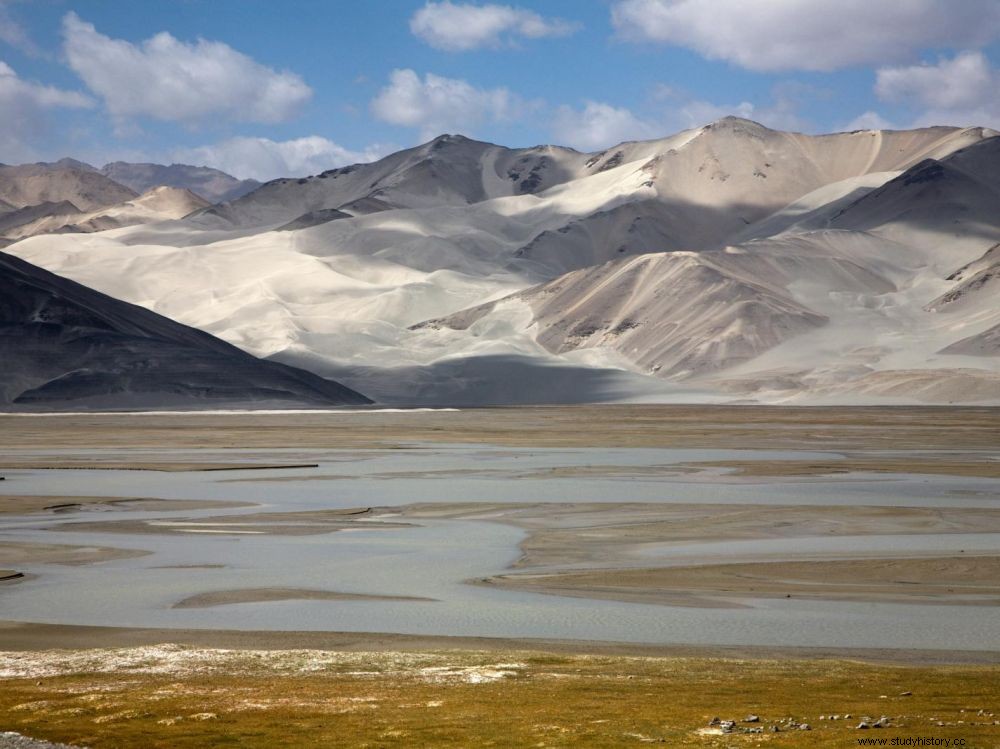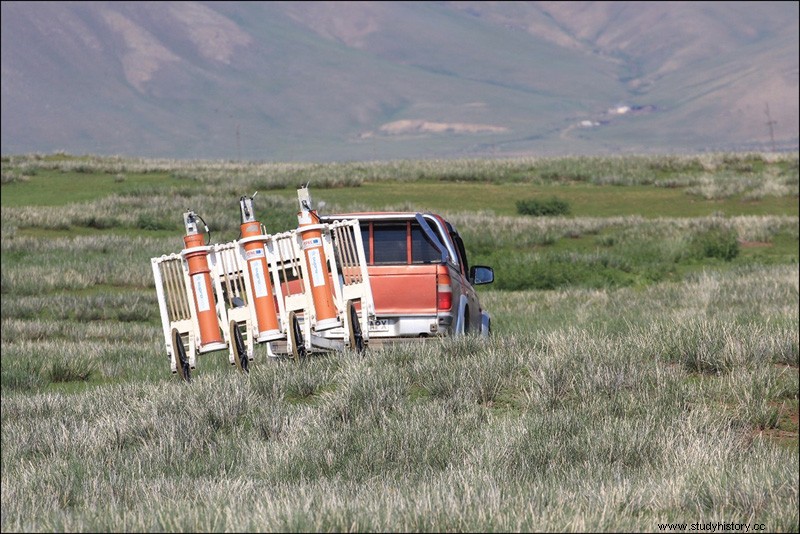Founded in the 13th century by Ögödei, son and successor of Genghis Khan, Karakorum was not a capital like the others. Intended to accommodate an itinerant court, it nevertheless had permanent constructions, in particular for the foreign population who operated it. But unlike medieval cities on the European continent, it remained open to the steppe, beyond its fortifications.

Mountain range in Karakorum
Karakorum, capital of the Mongol Empire, was founded in the 13th century by Ögödei Khan, son and successor of Genghis Khan. Probably abandoned at the beginning of the 15th century, its traces were gradually erased, while a Buddhist monastery was built on the ruins of the old palace from the following century. It was not until the end of the 19th century that an expedition on the spot gave rise to a first, summary map of the city – which turned out to be rather exact, as shown by the recent work of an interdisciplinary team of German researchers, published in the magazine Antiquity . For the first time, archaeologists from the University of Bonn, under the direction of Jan Bemmann, and physicists from the Leibniz Institute for Photonic Technologies (IPHT) in Jena have indeed succeeded in establishing a geomagnetic survey plan and topography of Karakorum. This survey shows that the Mongolian capital extended over a much larger area than previously thought, suggesting that to better grasp the shape of this "established" city in the steppe, it is necessary to abstract oneself from a European way of thinking which stops at the belt of a rampart.
Karakorum, capital of the Mongol Empire
In the year 1220, Genghis Khan (~1162-1227) chose to establish his camp (ordo ) at a particular site in the valley of the Orkhon River, where the high valley, in the form of a canyon, gives way to vast pastures. His son, Ögödei (1186-1241), in turn established the city of Karakorum there, the construction of which was completed during the reign of his successor, Möngke (1209-1259). Twice a year, Ögödei came to stay in his sumptuous palace, built in 1235, joined by the imperial elite who lived in residences all around. According to the eyewitness account of the Franciscan monk Guillaume de Rubrouck, sent in 1253 by King Louis IX of France, Karakorum also housed within its ramparts Chinese craftsmen, Muslim merchants (or "Saracens"> ) and captives from all over the empire.
This description of a fortified city with four gates will serve as the basis for all the archaeological teams that will go there in the 20th century, with the unfortunate consequence that they will all be limited to mapping the fortified area and the buildings located in front of the east gate. However, the first map of Karakorum, quickly drawn up by the orientalist Wilhelm Radloff during his 1891 expedition, already foreshadowed what aerial photographs from the 1970s and current satellite images would later indicate, namely that the city actually extended far beyond the fortified area.
SQUIDs provide magnetic ground scanning combined with GPS
The objective of the German researchers therefore consisted, during two field campaigns in 2016 and 2017, of mapping the extended area corresponding to this agglomeration (i.e. approximately 4.7 km²), in order to determine its size, extent, the location of the different neighborhoods, the layout of the streets and the access roads leading to them. For this, they used a process developed by the IPHT, consisting of 18 magnetic field sensors, called SQUIDS ("Superconductive Quantum Interference Detectors"), fixed on a platform towed by an all-terrain vehicle. This non-destructive magnetic scanning, combined with differential GPS, makes it possible to measure in great detail the footprint of man-made soil structures, even when they have been covered by agricultural land or steppe. The data thus generated over a total distance of 3,500 km was combined with that of the satellite images, then supplemented by a pedestrian survey.
Karakorum, capital of the Mongol Empire, was founded in the 13th century by Ögödei Khan, son and successor of Genghis Khan. Probably abandoned at the beginning of the 15th century, its traces were gradually erased, while a Buddhist monastery was built on the ruins of the old palace from the following century. It was not until the end of the 19th century that an expedition on the spot gave rise to a first, summary map of the city – which turned out to be rather exact, as shown by the recent work of an interdisciplinary team of German researchers, published in the magazine Antiquity . For the first time, archaeologists from the University of Bonn, under the direction of Jan Bemmann, and physicists from the Leibniz Institute for Photonic Technologies (IPHT) in Jena have indeed succeeded in establishing a geomagnetic survey plan and topography of Karakorum. This survey shows that the Mongolian capital extended over a much larger area than previously thought, suggesting that to better grasp the shape of this "established" city in the steppe, it is necessary to abstract oneself from a European way of thinking which stops at the belt of a rampart.
Karakorum, capital of the Mongol Empire
In the year 1220, Genghis Khan (~ 1162-1227) chooses to establish his camp (ordo ) at a particular site in the valley of the Orkhon River, where the high valley, in the form of a canyon, gives way to vast pastures. His son, Ögödei (1186-1241), in turn established the city of Karakorum there, the construction of which was completed during the reign of his successor, Möngke (1209-1259). Twice a year, Ögödei came to stay in his sumptuous palace, built in 1235, joined by the imperial elite who lived in residences all around. According to the eyewitness account of the Franciscan monk Guillaume de Rubrouck, sent in 1253 by King Louis IX of France, Karakorum also housed within its ramparts Chinese craftsmen, Muslim merchants (or "Saracens"> ) and captives from all over the empire.
This description of a fortified city with four gates will serve as the basis for all the archaeological teams that will go there in the 20th century, with the unfortunate consequence that they will all be limited to mapping the fortified area and the buildings located in front of the east gate. However, the first map of Karakorum, quickly drawn up by the orientalist Wilhelm Radloff during his 1891 expedition, already foreshadowed what aerial photographs from the 1970s and current satellite images would later indicate, namely that the city actually extended far beyond the fortified area.
SQUIDs provide magnetic ground scanning combined with GPS
The objective of the German researchers therefore consisted, during two field campaigns in 2016 and 2017, of mapping the extended area corresponding to this agglomeration (i.e. approximately 4.7 km²), in order to determine its size, extent, the location of the different neighborhoods, the layout of the streets and the access roads leading to them. For this, they used a process developed by the IPHT, consisting of 18 magnetic field sensors, called SQUIDS ("Superconductive Quantum Interference Detectors"), fixed on a platform towed by an all-terrain vehicle. This non-destructive magnetic scanning, combined with differential GPS, makes it possible to measure in great detail the footprint of man-made soil structures, even when they have been covered by agricultural land or steppe. The data thus generated over a total distance of 3,500 km was combined with that of the satellite images, then supplemented by a pedestrian survey.

IPHT SQUIDs in the Mongolian steppe. © Jan Bemmann
A city without clearly defined borders
As presumed by the researchers, the data indicate that the agglomeration extended beyond the walls of the fortified city, which only encompasses an area of 1.3 km², while traces of settlement are present in an area of approximately 12 km² including 259 sites. It has not been easy to interpret the remains found in this palimpsest that is the basement of Karakorum, but more than 60% of these sites date from the Mongol period. The city therefore not only extended beyond the ramparts, but there were no real precise borders, the surrounding areas being occupied up to almost 8 km from the eastern gate. There are, for example, burial sites, including a Muslim cemetery, but they may also have been used as temporary camps during large gatherings, such as assemblies of the ruling elite (khuriltai ).
Empty areas, even in the walled city
Even within the walled city, which covered 135 hectares, the population density was also not homogeneous, as it was only built on 60% of its surface. In the northern part, where the ground was covered only with gravel from the Orkhon River, there were no buildings, and moreover the low walls did not even form real ramparts, which leads researchers to assume that this area was not used as a permanent camp. The constructions are concentrated in the center of the city, where the Achnatherum proliferates today splendens (Trin.) Nevski, a grass that grows on loamy soils and signals brick structures in the subsoil. The presence of colored tiles and granite column bases suggests that there were Chinese-style buildings there, designed for the imperial elite, for administration or ritual activities.
Roads in every direction
The city was served by many access roads. The most used point was the East Gate, as indicated by the presence of two roads, lined with buildings, heading towards China. The northern path probably led to a lake about 60 km away, where it joined a major road. To the west, the paths lead to an ancient tributary of the Orkhon and may have served as a channel for water, which we imagine transported on carts, in containers or leather bags. The southern route is more difficult to identify due to the presence of the Erdene Zuu Buddhist monastery, built in 1586 on the ruins of the old fortified palace. Archaeologists have nevertheless found a large complex to the south of the city, probably corresponding to a craft area, as evidenced by the presence of brick or granite ovens used for metalworking.
A city created ex nihilo in the steppe
The image which is now offered to researchers is therefore very different from that which historians have had until now. For Jan Bemmann, the error not only consisted in relying solely on William of Rubrouck's account, for which the ramparts surrounded the entire city, but also in considering Karakorum, like the few cities of this steppe region , as a city that would not be designed for a sedentary society. However, even if the khan only came to Karakorum for a few weeks a year, the capital had permanent residences for the administration and the elite, areas of artisanal activities and places of worship, as well as a real city intended for a permanent habitat.
This is why scholars propose to call Karakorum a "settled city. ", because it was "inscribed by the sovereign in a landscape without fixed architecture ", and because the permanent inhabitants were outsiders. Indeed, the nomads of the steppe had nothing to do with the city, which functioned as a completely separate entity and unrelated to the surrounding pastoral population and economy. To imagine what Karakorum looked like, we must therefore detach ourselves from the European model and consider an urbanism created ex nihilo , as was the case for Brasilia in the 20th century.
